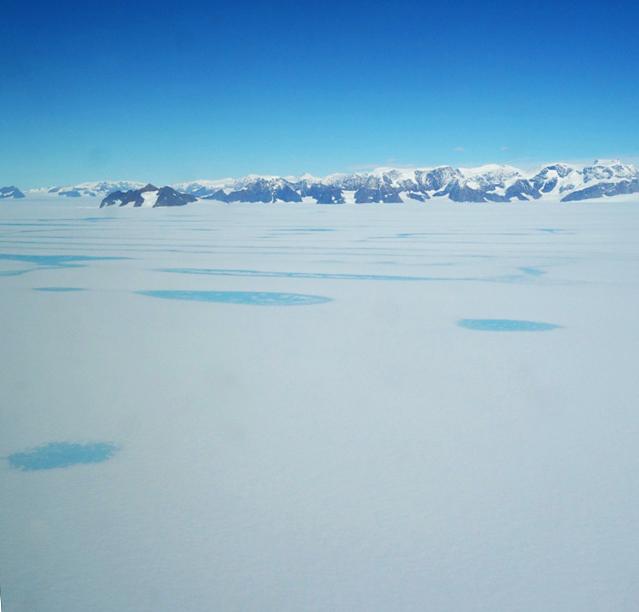

This image shows meltwater pools on the Larsen C ice shelf in Antarctica.
Credit: Jenny Turton (British Antarctic Survey)
The researchers observed the föhn winds, which blow around 65% of the spring and summer period, extend further south and are more frequent than previously thought, and are likely to be a contributing factor that weakens ice shelves before a collapse. The results are presented this week (Tuesday 25 April) at the European Geosciences Union General Assembly (EGU) in Vienna.
In 1995 and 2002, the Larsen A and B ice shelves collapsed, depositing an area the size of Shropshire into the Weddell Sea. Whilst ice shelf collapse doesn't directly contribute to sea level rise, the glaciers which fed into the ice shelves accelerated, leading to the loss of land ice, and subsequently indirect sea level rise.
The processes responsible for the collapse of these ice shelves were largely debated, and it is now thought that crevasses on the ice shelf were widened and deepened by water draining into the cracks. Föhn winds are thought to be responsible for melting the ice shelf surface and supplying the water.
The findings describe when and where the warm, dry winds occur over the Larsen C Ice Shelf, the largest remaining ice shelf on the Antarctic Peninsula (roughly the size of Wales). Föhn winds were measured from near-surface weather stations and regional climate model data over a five year period and observed all year-round, but were most frequent in spring.
PhD student and lead scientist on this project from British Antarctic Survey (BAS) and Leeds University, Jenny Turton says:
“What's new and surprising from this study is that föhn winds occur around 65% of the time during the spring and summer. And we didn't know how much they influence the creation of melt pools and therefore are likely to weaken the ice shelf. Whilst a high number occur in spring, the combined warming over a number of days leads to much more surface melting than was experienced during days without föhn winds. This is important, as melting during summer and re-freezing during winter weakens the ice surface, and makes it more at risk of melting again the following season.
“We know the ice shelf often melts a little during summer, however we have found that when föhn events occur as early as September (three months earlier than the start of the summer melt season), the ice shelf surface is melting. Now that we know how prevalent and spatially extensive these winds are, we can look further into the effect they are having on the ice shelf.”
###
Issued by the British Antarctic Survey Press Office:
Athena Dinar, Senior PR & Communications Manager, British Antarctic Survey, tel: +44 (0)1223 221 441; mobile: +44 (0)7909 008516; email: amdi@bas.ac.uk
For media enquiries at EGU (and photos of melt pools on Larsen C Ice Shelf) please contact Athena Dinar as above.
Other media enquiries to Jon Fuhrmann, British Antarctic Survey, tel: +44 (0)1223 221 506; mobile: +44 (0) 7850 541911: jonann@bas.ac.uk
Notes for Journalists
Jenny Turton will present her results at a press conference in the media centre at EGU. Polar Regions: Arctic sea-ice future, Antarctic ice-shelf stability, and glacial landforms takes place on Tuesday 25 April in the EGU Press Centre, 10.00 – 11.00.
Jenny Turton's poster will be on display Wednesday 26 April in Hall X5 board number X5.208, with her present 17:30 – 19.00.
Föhn winds were observed as far south as 68.1?S, for the first time as part of this study.
British Antarctic Survey (BAS), an institute of the Natural Environment Research Council (NERC), delivers and enables world-leading interdisciplinary research in the Polar Regions. Its skilled science and support staff based in Cambridge, Antarctica and the Arctic, work together to deliver research that uses the Polar Regions to advance our understanding of Earth as a sustainable planet. Through its extensive logistic capability and know-how BAS facilitates access for the British and international science community to the UK polar research operation. Numerous national and international collaborations, combined with an excellent infrastructure help sustain a world leading position for the UK in Antarctic affairs. For more information visit http://www.












